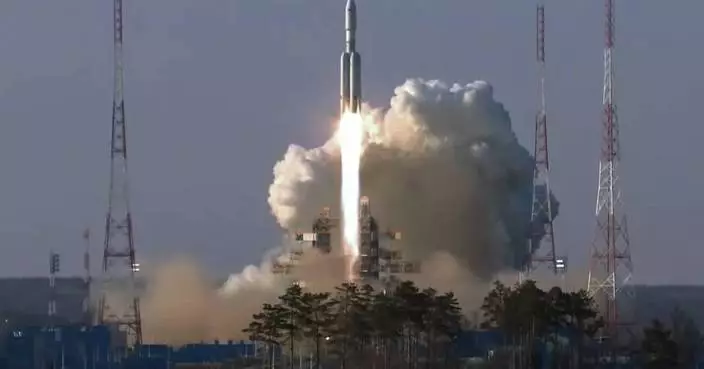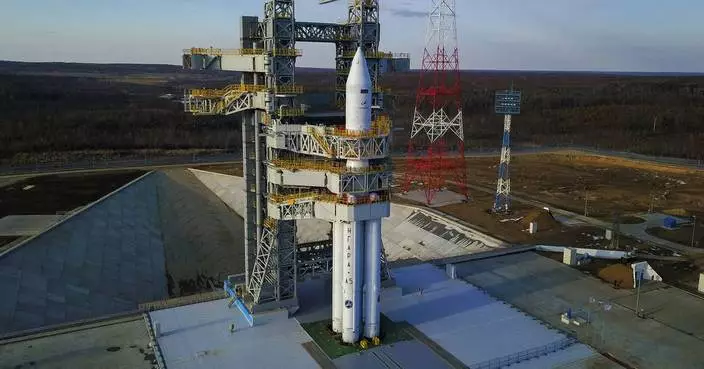Jeff Bezos' Blue Origin rocket company shot a capsule higher into space Wednesday than it's ever done before.
The New Shepard rocket blasted off from West Texas on the company's latest test flight. Once the booster separated, the capsule's escape motor fired, lifting the spacecraft to an altitude of 389,846 feet. That's 74 miles or 119 kilometers.
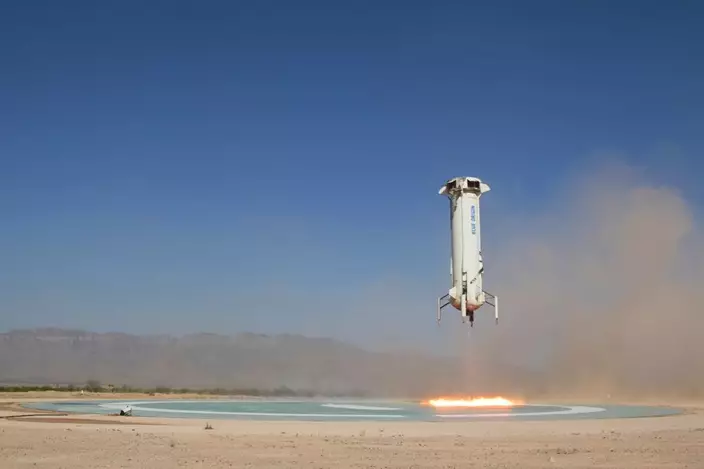
In this photo provided by Blue Origin, The booster of the New Shepard rocket prepares to land in a project called Mission 9 (M9) in western Texas on Wednesday, July 18, 2018. Jeff Bezos' Blue Origin rocket company shot a capsule higher into space Wednesday than it's ever done before. (Blue Origina via AP)
It's part of a safety system intended to save lives once space tourists and others climb aboard for suborbital hops.
Wednesday's passenger was Mannequin Skywalker, an instrumented dummy in a blue flight suit that's flown before, plus science experiments.
The booster and capsule — both repeat fliers — landed successfully. It was the ninth test flight and lasted 11 minutes.
"Crew Capsule looks great even after it was pushed hard by the escape test. Astronauts would have had an exhilarating ride and safe landing," Bezos said in a tweet . "Great engineering and the lucky boots worked again."
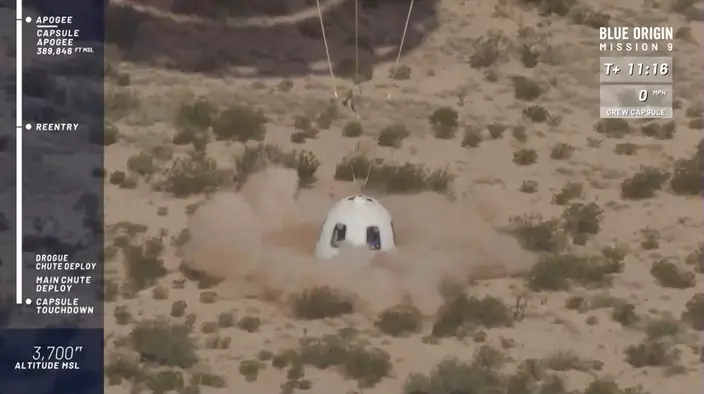
In this image from video made available by Blue Origin, the company's New Shepard capsule lands during a test in West Texas on Wednesday, July 18, 2018. Once its booster separated, the capsule’s escape motor fired, lifting the spacecraft to 74 miles (119 kilometers) as part of a safety system intended to save lives once customers _ including space tourists _ climb aboard for suborbital hops. (Blue Origin via AP)
Blue Origin has yet to announce when it will start selling tickets or how much flights will cost. Launch commentator Ariane Cornell promised it would be soon. "It's coming," she said.
Bezos, founder and chief executive of Amazon, aims to send people and payloads into orbit from Cape Canaveral. Those missions will rely on the bigger, more powerful New Glenn rocket still under development.
He's named his rockets after NASA's original Mercury astronauts Alan Shepard, the first American in space, and John Glenn, the first American to orbit the Earth.
TOKYO (AP) — Japan’s space agency announced Friday a plan to launch a major upgrade to its satellite imaging system, as a new flagship rocket is put to the test for a third time.
The Japan Aerospace Exploration Agency that an H3 rocket will be launched from the Tanegashima Space Center, on a southwestern Japanese island, early afternoon on June 30, with a launch window that runs through the end of July.
The rocket will be carrying an Advanced Land Observation Satellite, ALOS-4, tasked primarily with Earth observation and data collection for disaster response and mapmaking, as well as with monitoring military activity, such as missile launches, with an infrared sensor developed by the Defense Ministry. The ALOS-4 is a successor to the current ALOS-2 and can observe a much wider area.
The launch will be the H3's third, coming after a failed debut in March 2023 and a successful launch on Feb. 17. During the first attempt, the rocket's second stage engine did not ignite and the rocket had to be destroyed along with its main payload, a satellite that was supposed to be the ALOS-3.
During H3 No. 2's successful test flight, it carried two commercially-developed observation microsatellites and an ALOS mockup.
JAXA and its main contractor Mitsubishi Heavy Industries have been developing H3 as a successor to its current mainstay, H-2A, which is set to retire after two more flights. MHI will eventually take over H3 production and launches from JAXA and hopes to make it commercially viable.
Japan sees a stable, commercially competitive space transport capability as key to the country's space program and national security.
The 57-meter (187-foot) long H3 rocket is designed to carry larger payloads than the H-2A at about half its launch cost.

FILE - JAXA H3 rocket project managers Masashi Okada, right, and Mayuki Niitsu brief journalists in front of the second stage of a H3 rocket, set for a full-fledged launch later this year after two test flights, inside the Mitsubishi Heavy Industries' Nagoya Aerospace Systems Works Tobishima Plant in Tobishima, Aichi prefecture Thursday, March 21, 2024. Japan’s space agency announced Friday, April 26, that it will launch its new flagship rocket H3 on June 30 carrying an observation satellite for disaster response and security purposes, a key mission that it had failed in its debut flight last year. (AP Photo/Mari Yamaguchi, File)
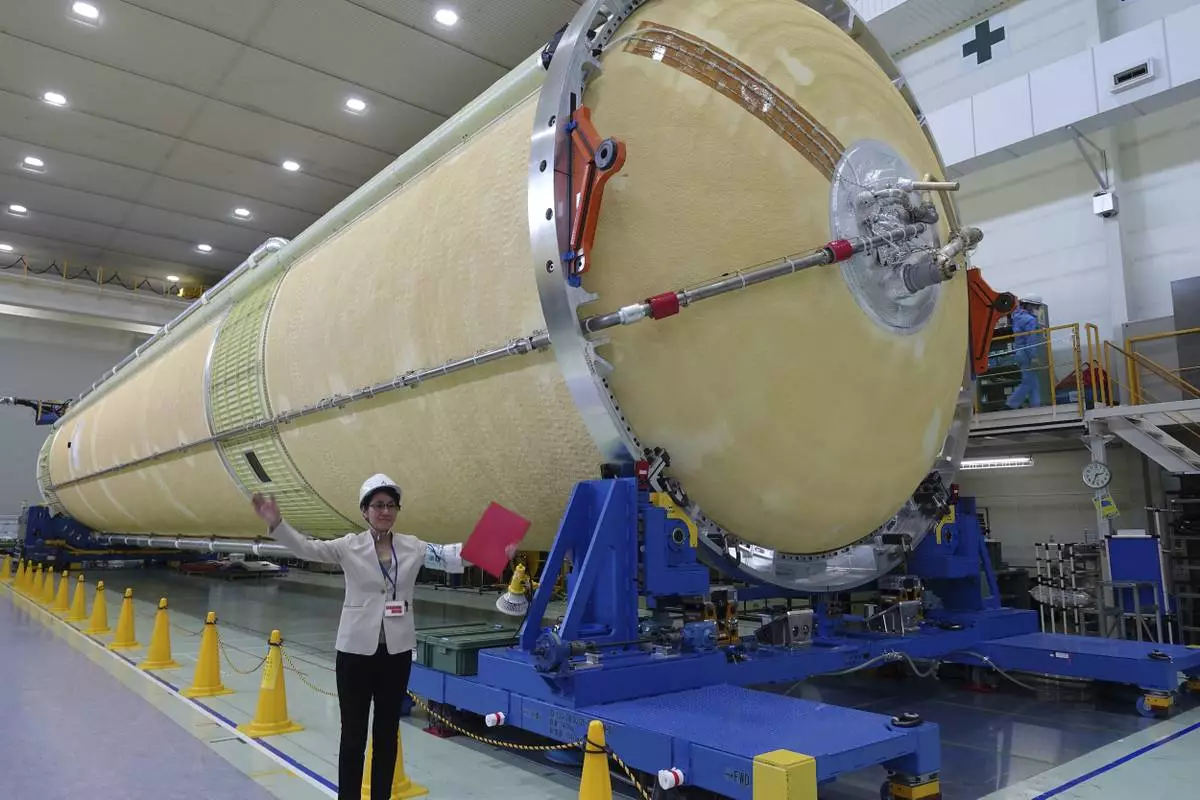
FILE - A Mitsubishi Heavy Industries staff member stands next to the top of the first stage of a H3 rocket, inside the Mitsubishi Heavy Industries' Nagoya Aerospace Systems Works Tobishima Plant in Tobishima, Aichi prefecture Thursday, March 21, 2024. Japan’s space agency announced Friday, April 26, that it will launch its new flagship rocket H3 on June 30 carrying an observation satellite for disaster response and security purposes, a key mission that it had failed in its debut flight last year.(AP Photo/Mari Yamaguchi)








